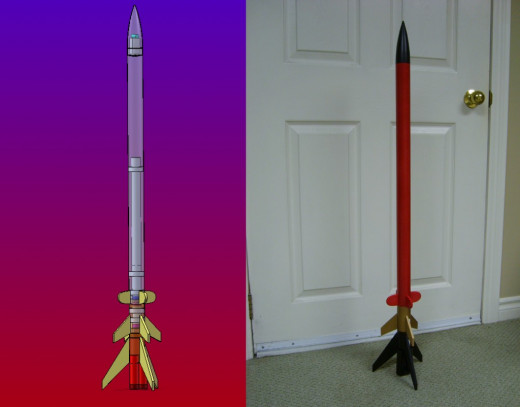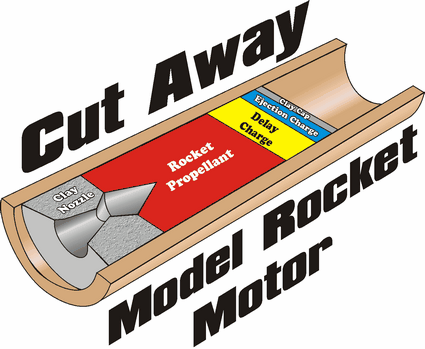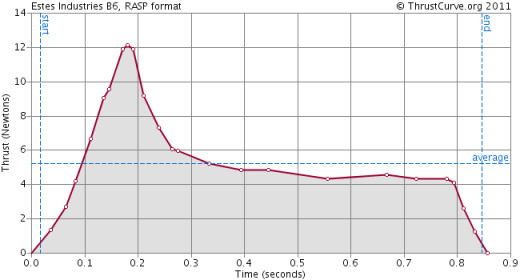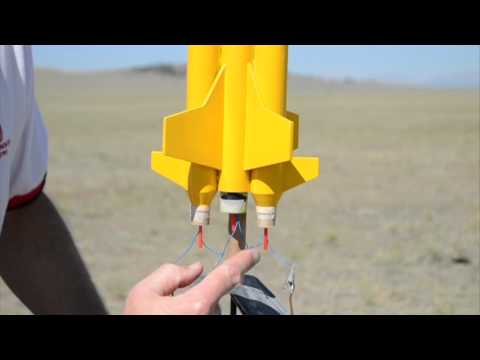R is for Rocket - Rocket Motors

Don't You Mean Rocket Engine?
No, that's a common misunderstanding. Engines contain moving parts, cams, linkage, etc. Engines are in fact a subset of all motors. A motor is simply something that imparts motion... which is what a rocket motor does, without the need for any moving parts. Not that I wish to dwell on semantics but rocket motors are important enough to deserve their own literature so it's a good idea to get intimate with them and know everything about them. The more you know about rocket motors, the safer you will be and that's ultimately the purpose of this article. The motor, like any other part of the rocket can affect its performance but a rocket is otherwise harmless to you and others except for the fact that it moves under power without a guidance system. Learn your rocket motors and you'll reduce the risk of injury.
The Anatomy of a Rocket Motor
There are several companies that manufacture rocket motors: Estes, Quest, Aerotech, Cesaroni and others. In certain jurisdictions you can even make your own motors but in mine, you can't and in general I don't recommend it unless you're way smarter and more experienced than you should be if you're reading this hub right now. Building your own motors involves handling dangerous chemicals and using processing methods that are less reliable than those found in large manufacturing facilities that do this day in and day out. Not only could you hurt yourself or others making the motor but if you don't do it then, you could hurt someone when you fire the thing off. It could explode on the pad, in the air or in someone's face. Even if it doesn't fail, you don't know what sort of performance to expect from the motor unless you have excellent manufacturing repeatability and extensive load cell testing. Use your discretion but whatever you do, be careful at all times.
Manufactured motors are mostly similar in construction. They have an outer casing that's made of wound paper or some sort of molded composite. At the very bottom of the motor is the nozzle, which is extremely important because it has very delicately tuned geometry designed to direct the hot exhaust gasses to achieve a certain chamber pressure and thrust. Damage to the nozzle can cause the rocket to fly off course and it doesn't take much.
On top of the nozzle sits the propellant grain, which is sometimes modular, as with re-loadable motors or hydraulically pressed into place in many of the single-use motors. The propellant grain can be as simple as black powder for low impulse motors or it can be similar in composition to the space shuttle's solid rocket booster propellant, which is an aluminum-perchlorate blend and has a rubbery consistency to it. This type of propellant is higher impulse and has greater efficiency. The propellant grain may have various cross sections, depending on the desired thrust curve. It may be an end burner (solid throughout), a modified end burner (mostly solid with a small bore near the nozzle for extra thrust at lift-off), a core burner (most, if not all of the grain has a bore running up the length or some other complex bore geometry like a star shape, a C-shaped notch, etc. All of these cross sections are specifically designed to force the propellant grain to burn a different way with the burning surface changing predictably over time to yield a specific thrust curve. You typically don't need to know the intricacies of the grain geometry because the motor's designation will tell you what it's meant to do.

On top of the propellant grain may be what's called a "delay" grain. This is a different type of propellant that burns slowly and produces little to no thrust. It usually produces a large volume of visible smoke as well. As the name suggests, its purpose is to act as a timer, allowing the rocket to coast after the fuel is spent.
On top of the delay there will be a deployment charge or ejection charge. This is similar to flash powder. It explodes quickly and violently (the exact opposite of the delay). Its purpose is to produce a rapid increase in pressure inside your rocket's body tube. It is this sudden pressure wave that literally shoves everything in the tube out of the way, dislodging the nose and blowing everything out the top of the rocket. It's required in any stage that has a recovery system like a parachute and it's the only way the motor has to deploy such a device. It's very important that the ejection charge works as intended so don't use too small a motor with too big a body tube and don't make the nose so tight a fit that it can't come off. Basically don't make it impossible for this puff of gas to deploy the recovery system by blocking everything up.
On top of the ejection charge is some sort of a very weak bulkhead made of either paper or clay or something which can be easily dislodged or destroyed. It merely contains the ejection charge without blocking it when it goes off.
Some motors are designated as "booster" motors which means they are meant to ignite a stage directly on top of them. This is done by deleting every part of the motor above the propellant grain so you can actually see the grain if you look down on top of the motor. Once the grain burns all the way through whatever burning fragments are left over will shoot up through the casing and "ideally" enter the nozzle of the motor sitting above, igniting it.
Rocket Motor Life Cycle
An important note is that when igniting a second stage, the ignition process can unintentionally behave like the ejection charge deploying in that a lot of pressure builds up in the inter-stage cavity. This "can" separate the 2 stages prior to successful ignition. It's important to provide adequate VENTING to your rocket so that gasses escaping from the top of the stage 1 motor can exit up or down through one of the body tubes, perhaps through a centering ring while the burning propellant fragments are too heavy to follow and will continue up through the stage 2 nozzle as intended. Don't over-vent however because the ensuing blast from the stage 2 engine needs to separate the 2 stages, else you'll char the hell out of stage 1 before it falls off.
A Typical Time-Thrust Curve

Motor Designations
All motors are divided into classes, denoted by letters of the alphabet. These are IMPULSE classes. Impulse is essentially a measure of the total energy of the motor. The higher the impulse the more motive force and/or speed it can impart to your rocket. Each impulse class is roughly double the one that comes before it. Therefore class B has roughly twice the impulse as class A, C has twice that of B and so forth. The classes range from 1/4A all the way up to O and beyond although for practical hobby purposes you're looking at A to E for hobby models. Anything H or higher is considered "high impulse" and requires certification while F and G are sort of in between. In any case, this impulse rating is the first letter you will see printed on the motor code.
Right next to your impulse letter there will be a number, a positive integer that represents the "average thrust" of the motor, measured in Newtons. A motor designated C6 for example is of the C impulse class (5-10 N-s) and has an average of 6 N of thrust. This can be thought of as taking the area under the thrust curve and dividing it by the duration although it's not quite that simple. It is however more or less what you can expect out of the motor for most of the burn time so if you need 6 N of sustained thrust, you'll want a motor with a 6 after the letter.
The last part of the motor code is a - followed by another number. This final number represents the "delay duration". This is how many seconds elapse between when the propellant finishes burning and the ejection charge goes off. It's how long the delay propellant burns. This is a very important number because you need to know roughly how long your rocket will coast before it reaches its maximum altitude and you need to know this before you fly the rocket. Why? Because if you're way off the rocket will be traveling at tremendous speed, either up while coasting or down as it falls to the ground. In both scenarios, the recovery system hasn't been deployed yet so the rocket is very streamlined and will be moving very fast, making it dangerous. If the delay is too short or too long and the recovery system deploys when the rocket is moving too fast, it may not deploy properly or the recovery system may be destroyed by air drag. If that happens your rocket will fall quickly and could hurt someone. If you're building a kit, the kit will tell you which delay to use. If you're building your own rocket, sorry but you'll have to do some math or use some software to figure it out, at least good enough to pick the delay within an error of 3 seconds or so. If you stick a C6-3 into a rocket that has a projected altitude of 1200 feet you're just asking for it because the coasting time will be much higher than 3 seconds. You'd want to use a C6-7 in that case.
Note that booster motors will have a 0 in the delay part of the code as in C6-0. This tells you it's a booster motor and doesn't have a delay at all. It won't have an ejection charge either so DON'T put one of these into a stage that needs a parachute. It won't work and you'll be launching a ballistic missile, not a model rocket.
Ignition System Setup

Motor Ignition
All model rocket motors are ignited electrically. If you do it any other way, you're literally playing with fire. It's not in the spirit of model rocketry to use anything but electrical ignition because it's dangerous so don't ruin the hobby for the rest of us by becoming a statistic.
Electrical ignition is very easy. You will have an igniter which can be purchased but usually comes with the motors when you buy them anyway. The igniters are just a couple of wires with a thin filament like what a toaster uses, bridging the wires. Not all igniters look like this but this is the simplest and the one you are most likely to see when you start doing rocketry. Sometimes the filament is covered with a dried paste that flares up when heated to make the ignition process more reliable. Running electricity through these igniters heats up the tip until it's red hot and sets the paste on fire which then ignites the propellant grain. Since the igniter is installed by dropping the end into the nozzle and holding it in place with a rubberized plug, the tip will be in direct contact with the propellant and will ignite it readily. Different igniters have different voltage requirements ranging from 6V up to 18V sometimes, depending on the igniter and the wire you're using. Speaking of wire, the igniter, once installed, is connected to alligator clips, which are connected to a long length of cable to put some distance between you and the rocket. The cable, like the igniter, will have 2 wires and at the ends of the wires you'll either hook them into a launch controller that you bought (or built) of you can simply touch the ends to a strong battery like a 9V, lantern battery or car battery. The voltage has to be just right so as to heat the igniter sufficiently without vaporizing it but as far as the current handling capacity of your voltage source is concerned, bigger is better. For example, having 100 x 9V batteries connected IN PARALLEL is perfectly fine and is much better than 1 battery but even 2 x 9V IN SERIES (18V) is not ok, even though it seems far less exaggerated. You want high current capacity but very specific voltage.
Electrical Ignition Close-Up
Motors Summed Up
Motors are tiny little powerplants with multiple stages of operation. The manufactured motors are rigorously tested and manufactured repeatably and reliably. They are safer than common cigarette lighters to handle and won't give you any problems if you use them as directed. There are a ton of different motor out there with different thrust curves, which gives you the flexibility to pick the one that's right for your model. Thrustcurve.org is a great site to actually see for yourself how the motor will perform and as I said earlier, you need to know this so you can figure out what delay to use. Have a look there. It's a really cool site. In the mean time, have fun with rocketry!








